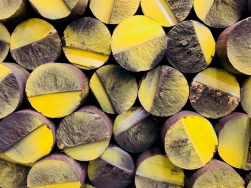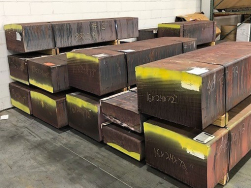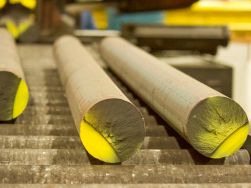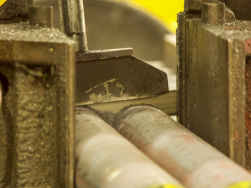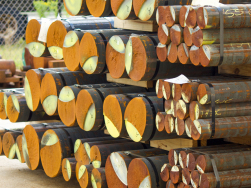Ductile Iron Supplier
Dura-Bar® ductile iron is a cost-saving alternative to low-medium carbon steels. Dura-Bar® ductile iron is often used as an alternative to plain carbon steel and has similar strengths with excellent free machining properties. Dura-Bar® 65-45-12 is a good replacement for low-carbon steel grades such as 1018, 1117, 1212, and 12L14. 80-55-06 can be an alternative to medium-carbon steels such as 1141, 1144, and 1045. SSDI (Solution Strengthened Ductile Iron) grade combines the elevated mechanical strengths of a pearlitic ductile iron with the machinability advantages of a ferritic ductile iron. All grades are equally able to be hardened. The nodular graphite provides the same free machining benefits as lead, without creating machining and waste disposal problems. Ductile grades will conform to ASTM A536, with the primary difference being the high nodule count and fine grain size inherent to the Dura-Bar® continuous casting process. The different grades are produced by controlling the matrix structure around the graphite nodules. See Dura-Bar Iron Stock Allowances for details.
65-45-12 Ductile Iron
Dura-Bar® 65-45-12 ductile iron contains nodular graphite in a matrix of ferrite with small amounts of pearlite. The ferritic structure gives excellent machinability with good surface finishes along with optimal impact strengths, fatigue properties, electrical conductivity, and high magnetic permeability. This iron has approximately the same tensile and yield strengths as AISI 1020 steel in the as-rolled condition. This specification conforms to ASTM A536 grade 65-45-12.
Microstructure of 65-45-12 Ductile Iron
The microstructure consists of Types I & II nodular graphite as defined in ASTM A247. The matrix is ferrite with approximately 5-25% pearlite. The edge or rim will have a higher nodular count and will be mostly ferrite. Chill carbides will be less than 5% in any field at 100x and will be well dispersed.
Heat Treated Response
Dura-Bar® 65-45-12 can be oil quench hardened from 1600° F (885° C) to Rockwell C 50 minimum on the outside of the bar. The hardness in the core will be less than the hardness on the outside surfaces. Any grade of ductile iron can be quenched and tempered to 50 – 55 Rc.
This grade also responds well to surface hardening methods such as flame or induction heat treating. It is well suited for austempering because of the low residual alloy content, and the highly ferritic matrix provides predictable growth with minimal heat distortion. Get more details including typical Jominy end quench curve, methods and cycle times, and temperature effects by downloading the Dura-Bar® Heat Treating Guide.
80-55-06 Ductile Iron
Dura-Bar® 80-55-06 ductile iron will contain nodular graphite in a matrix of ferrite and pearlite. The pearlite/ferrite structure provides higher wear resistance and strength when compared to a ferrite grade of ductile iron. This material is readily machinable with good surface finishes. Tensile and yield strengths are similar to AISI1040 steel in the as-rolled condition. This specification is similar to ASTM A536 grade 80-55-06.
Microstructure of 80-55-06 Ductile Iron
The microstructure consists of Type I & Type II nodular graphite as defined in ASTM A247. The matrix is pearlite and ferrite. The edge or rim has a higher nodule count and ferrite content. Chill carbides will be less than 5% in any field at 100x and will be well dispersed.
Heat Treated Response
Dura-Bar® 80-55-06 can be oil quench hardened from 1600° (885° C) to a minimum hardness of Rockwell C 50 on the outside of the bar. The inside diameter hardness will be less than Rockwell C 50. Lower quench hardness on the inside diameters is a result of larger graphite nodules and not a loss of matrix hardness. Get more details including typical Jominy end quench curve, methods and cycle times, and temperature effects by downloading the Dura-Bar® Heat Treating Guide.
100-70-03 Ductile Iron
Dura-Bar® 100-70-03 ductile iron contains nodular graphite in a matrix of pearlite with small amounts of ferrite. The pearlitic structure maximizes strength and wears characteristics in a non-alloyed as-cast ductile iron. For more information regarding the machinability of 100-70-03, click here. This specification is similar to ASTM A536 100-70-03.
Microstructure 100-70-03 Ductile Iron
The microstructure consists of Type I & Type II nodular graphite as defined in ASTM A247. The matrix is highly pearlite with small amounts of ferrite. The edge or rim will have a higher nodule count and contain slightly higher ferrite concentration when compared to the center. Chill carbides will be less than 5% in any field at 100x and will be well dispersed.
Heat Treated Response
Dura-Bar® 100-70-03 can be oil quench hardened from 1600° F (885° C) to a minimum hardness of Rockwell C 50 on the outside of the bar. The inside diameter hardness will be less than Rockwell C 50. Lower quench hardness on the inside diameters is a result of larger graphite nodules and not a loss of matrix hardness. Get more details including typical Jominy end quench curve, methods and cycle times, and temperature effects by downloading the Dura-Bar® Heat Treating Guide.
SSDI (Solution Strengthened Ductile Iron)
Dura-Bar® SSDI is a grade of ductile iron that combines the elevated mechanical strengths of a pearlitic ductile iron with the machinability advantages of a ferritic ductile iron. By combining the best of both desired properties, Dura-Bar® SSDI is an attractive grade of ductile iron that provides several benefits for designing and manufacturing metal components. With improved strength and ductility, SSDI is an excellent alternative to 1045 steel used in a variety of oil & gas and fluid power applications. SSDI has been shown to yield approximately 30% greater productivity in addition to no negative impact on tool wear.
Microstructure of SSDI Iron
The microstructure consists of Types I & II nodular graphite. Microstructure attributes can be summarized as 85% nodularity. Pearlite percentage for the center and edge of the bar is 5 to 30% and 0 to 15% respectively.
Heat Treated Response
Initial test results prove Dura-Bar® SSDI can be oil quench hardened from 1650° F (898° C) to a hardness Rockwell C of 35-40. From these tests, it can be concluded that there is overall uniformity and consistency to grade SSDI. When untreated, SSDI's microstructure is primarily ferritic, however, when heat treated, the microstructure changes and becomes martensitic. For more details regarding heat treatment, click here.
Ductile Iron Applications (All Grades)
Construction & Heavy Equipment:
- Bushings, Flywheels, Gears, Bearing Housings, Journals, Pulleys, Rams, Side Frames, Tie Rod Nuts, Bearing Caps
Agriculture:
- Gears, Valve Guides, Numerous Hydraulic Applications, Pump Housings, Pulleys
Infrastructure:
- Cement Rollers, Numerous Hydraulic Components, Guide Rolls, Pinch Rolls, Runout Table Rolls
Fluid Handling:
- Cylinder Blocks, End Caps, Gear Rack Housings, Gerotors, Glands, Manifolds, Rotors, Valves, Hydraulic Gears, Hydraulic Cylinder Pistons, Cylinder Rod Guides, Spools, Liners, Rotary Screws
Machinery:
- Rotary Screws, Compressor Rotors, Coupling Hubs, Gears, Pulleys, Sprockets, Chuck Bodies, Die Blocks, Spindle Housings, Rotary Tables, Barrell Rollers, Bushings, Chain Sheave Rollers, Flywheels, Gear Racks, Pile Drivers, Press Rams, Tie Rod Nuts
Oil & Gas:
- Plungers, Oil Pump Gears, Pony Rods, Plunger Pins, Static Cement Plugs
Energy:
- Flexible Shaft Couplings, Pulleys, Gears, Bushings, Sleeves, Bearing Caps, Brake Pins, Wear Plates
General Fabrication & Machining:
- Plunger Pins, Bank Molds, Plungers, Fire Hydrant Water Valves, Chain Drive Sprockets, Port Plates, Core Boxes, Patterns, Dies, Disamatic Pouring Rails & Plates, Grinding Rolls, Mill Liners
Automotive & Transportation:
- Coupling Hubs, Gears, Pulleys, Rail Spacers, Sprockets, Motorcycle Disc Brakes, Camshafts, Carriers
As-cast round bars are made to clean up at the nominal size. Additional stock is added to allow for out-of-round and normal imperfections in the as-cast surface.
View All
As-cast squares are made to the actual size with no allowance for machine stock added. Squares are cast to actual dimension, with clean up stock dependent on the height and width ratio.
View All
As-cast rectangles are made to the actual size with no allowance for machine stock added. Rectangles are cast to actual dimension, with clean up stock dependent on the height and width ratio.
View All
Trepanned tubes are stocked in 72" lengths, but can be produced in longer lengths upon request. Tubes are typically stocked in 65-45-12 grade but when requested, other ductile iron grades can also be trepanned dependent on available diameters.
View All
Industrial Tube & Steel Corp offers cold finished milling as an added service for rectangular and square bars. Many sizes are available from stock, and additional sizes can be custom ordered.
View All
From one piece to production quantity, material is saw cut from large billets to your exact dimensional requirements. Simply give us your finish sizes and we will provide you with cut parts guaranteed to clean up to your finish dimensions
View All


